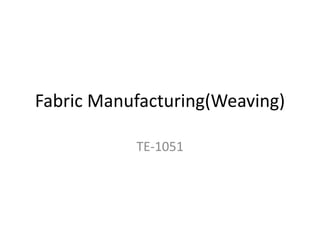
fabric manufacturing
- 2. WEAVING: • Weaving is a process of interlacing of warp and weft yarn at right angle to each other . There are practically an endless number of ways of interlacing warp and filling yarns .Weaving of yarns into a fabric is performed on a "weaving machine" which has also been called a "loom". In practice, the weaving machines are named after their filling insertion systems.
- 3. History • Based on the filling insertion systems, the weaving machines can be classified as shuttle and shuttleless weaving machines. Shuttle looms have been used for centuries to make woven fabrics. In this type of loom, a shuttle, which carries the filling yarn wound on a quill, is transported from one side to the other and back. In the mid 20th century, other weaving machines started to emerge that used other forms of filling insertion mechanisms such as air, projectile, rapier and water. In reference to shuttle looms, these machines are called shuttleless looms or shuttleless weaving machines. Today, the shuttle looms have become obsolete and are not manufactured anymore except for some very special niche markets. Continued
- 4. • The existing shuttle looms have been replaced by the shuttleless weaving machines in industrialized countries. Nevertheless, approximately 2.6 million of the 3.2 million looms in existence throughout the world in 1998 were still shuttle looms . However, they are being replaced by the shuttleless weaving machines at a fast rate. Today, the three most popular weaving machines are air-jet, rapier and projectile machines “Handbook of Weaving by Sabit Adanur, P-4,6”
- 6. Flow Chart of Weaving “Handbook of Weaving by Sabit Adanur, P-4,6”
- 7. Process involved in weaving • Winding/Rewinding – In fabric manufacturing, directly winding is not so much important, but rewinding is importan,after warping some packages contain just a few grams of yarn which is unsuitable for the efficiency of further processing, such as warping, twisting, and quelling. This necessitates the preparation of a dense and uniform yarn package of sufficiently large size from unsuitable packages which can unwind in the subsequent operations without interruptions, is called rewinding.
- 8. Warping: • In general terms, warping is transferring many yarns from a creel of single end packages forming a parallel sheet of yarns wound onto a beam.
- 9. Sizing • The weaving process requires the warp yarn to be strong, smooth and elastic or extensible to a certain degree. To achieve these properties on warp yarns, a protective coating of polymeric film forming agent (size) is applied on the warp yarns prior to weaving; this process is called slashing or sizing. • The Purposes of sizing : – To reduce the yarn hairiness that would interfere with the weaving process – To protect the yarn from yarn-to-yarn and yarn-to-loom abrasion – To increase the strength of the yarn. To protect the yarn from various yarn-to- yarn and yarn-to-loom abrasion. 3) To increase the strength of the yarn
- 10. Drawing-In After sizing, the sized warp beam is prepared to be placed on the weaving machine and for this purpose drawing-in is done. It is the entering of yarns from a new warp into the weaving elements of a machine, namely drop wires, heddles and reed, when starting up a new fabric style. Drop Wire Healed Wire Reed
- 11. Tying-in the new warp ends to the depleted warp is done when a new pattern is not required. TYING-IN
- 12. Weaving: • Weaving is the interlacing of warp and filling yams perpendicular to each other t form a fabric. Basic mechanisms which are essential for continuous weaving are: – Warp let-off – Shedding – Filling Insertion – Beat-up – Fabric take-up
- 13. The passage of the warp through a loom
- 14. In order to interlace warp and weft threads to produce fabric on any type of weaving machine, three operations are necessary : A)Shedding Separating the warp threads, which run down the fabric into two to form a tunnel known as the shed B)Picking Passing the weft thread, which traverses across the fabric, through the shed C)Beating-up Pushing the newly inserted length of weft, known as the pick, into the already woven fabric at a point known as the fell
- 15. Weaving Principles Weaving means to make cloth and other objects. Threads or strands of material are passed under and over each other. • WARP: – The length wise yarns which run from the back to the front of the loom, which forms the basic structure of the fabric and are called the warp. Warp yarns are yarns that are parallel to the selvedge which run through the length of the fabric • WEFT/Fill: – Crosswise yarns that run across the loom are called the weft / filling yarns. Weft yarns are yarns that are perpendicular to the selvedge which run through the width of the fabric
